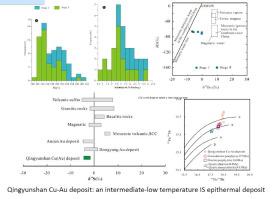Ore Geology Reviews ( IF 3.3 ) Pub Date : 2021-01-20 , DOI: 10.1016/j.oregeorev.2021.104006 Fan Xiao , Fei-Peng Fan , Guang-Fu Xing , Shao-Yong Jiang

|
The Qingyunshan Cu-Au deposit, located in the Dehua-Youxi area (Fujian Province, southeastern China), is a vein-type deposit that occurs along fractured zones in the Late Jurassic volcanic-sedimentary rocks and Early Silurian intrusions. Three mineral paragenetic stages are identified, including the pyrite-quartz veins (stage I), polymetallic sulfide-quartz-calcite veins (stage II), and calcite (±siderite)-chalcedony-comb quartz veins (stage III). The stage II is the main mineralization stage, dominated by pyrite, chalcopyrite, and galena as well as two generations of Fe-poor sphalerite with average Fe content of 0.84 wt.% in the early sub-stage and 0.31 wt.% in the late sub-stage. Fluid inclusion studies indicate that the stage I has a temperature of 220–240°C and salinity of 3.00–3.50 wt.% NaCleq., whereas the stage II has lower temperature (140–160°C), but similarly low salinity (2.50–3.00 wt.% NaCleq.), suggesting it is an intermediate-low temperature epithermal deposit. Hydrogen and oxygen isotope data indicate the fluids of stage I has a δD value of -72.5 to -69.5‰ and δ18Ow value of -2.96 to -0.46 ‰, whereas the stage II fluids show similar or slightly higher δD value (-68.0 to -66.5‰), but significantly lower δ18Ow value from -6.96 to -6.26‰, which suggest meteoric water predominated in the ore-forming fluid and shows an increasing trend from stage I to II. The δ34S values of sulfide minerals are between -3.7 and -2.3‰, consistent with a major magmatic sulfur source. The lead isotope data show a relatively narrow range with 206Pb/204Pb, 207Pb/204Pb, and 208Pb/204Pb values of 18.392–18.513, 15.642–15.758, and 38.497–39.043, respectively. These Pb-isotope data are similar to those of the Late Jurassic intrusions, but quite different from those of the surrounding rocks of Early Silurian quartz diorite. Pyrite from the ores yielded a Re-Os isochron age of 158.1 ± 9.3 Ma, which is similar to the zircon U-Pb age (162.0 ± 1.0 Ma) of the host dacite crystal tuff in the Nanyuan Formation. Therefore, we concluded that the Late Jurassic magmatic activity (ca. 160 Ma) has a genetic relation with formation of the Qingyunshan vein-type Cu-Au deposit, for which the ore metals were mainly derived from the magma, but ore-forming fluids evolved from a mixing of magmatic fluids and meteoric water with the later playing a major role in the main stage of ore formation.


























 京公网安备 11010802027423号
京公网安备 11010802027423号